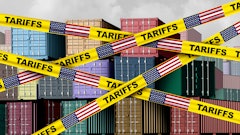
The last several months have highlighted a stark reality for global supply chains: persistent disruption. The end of 2024 saw a major port strike creating uncertainty and delays for businesses reliant on maritime shipping. Disruptions continued into early 2025, with major shifts in the global trade landscape, including the threat of widespread tariffs, further complicating international commerce.
For businesses, this turbulent reality demands a complete rethinking of supply chain strategies and a strong focus on building resilience. This is especially critical for small and medium-sized businesses (SMBs), which often lack the resources and flexibility of larger enterprises. The question becomes: how can SMBs adapt in this environment? The answer is investing in advanced technologies, particularly AI, which can serve as a crucial tool to not just survive but actively manage and mitigate the impact of ongoing disruptions.
However, while 81% of SMBs recognize that AI will be key to success in 2025, adoption is slow. A Netstock survey shows that only 23% of sampled SMBs report current AI investments.
Let's explore why AI is crucial for SMBs navigating today's complex supply chain landscape.
Out with the Old
While advanced technologies have transformed how large enterprises operate, many SMBs still rely on outdated methods like spreadsheets and manual forecasting. This reliance creates challenges.
First, limited visibility makes it nearly impossible to gain a real-time understanding of inventory levels across the supply chain, hindering effective decision-making. For example, a small clothing store might rely on manual inventory counts. If a popular item sells out quickly in the morning, they won't know to restock until the end of the day when they do their manual count. This leads to lost sales opportunities throughout the day.
Another example: with traditional forecasting, which relies heavily on historical data, businesses will struggle to anticipate the sudden disruptions that have now become commonplace. This means inaccurate predictions and inefficient inventory management. Consider a small electronics manufacturer that uses historical data to forecast demand for its products. Suddenly, escalating trade tensions lead to new tariffs and import restrictions. Traditional forecasting, based only on past production rates and readily available components, would struggle to adapt.
In with the New
Fortunately, AI can empower SMBs with the confidence to overcome the limitations of traditional supply chain management processes. It can analyze massive datasets to provide insights for successful planning. This leads to better decision-making, improved customer service, and increased profitability. Ultimately, AI tools can drive a shift in mindset–from reactive to proactive, helping SMBs become more prepared for disruptions.
Instead of sifting manually through complex spreadsheets, SMBs should leverage AI powered tools that summarize key metrics to provide clear, actionable recommendations. For example, if a business has historically overstocked a particular product due to inaccurate manual forecasting, the AI can identify this trend, recommend reducing future order quantities, or even suggest strategies for clearing existing excess stock. This translates to faster, more informed decision-making around inventory optimization and more effective use of resources.
Where traditional methods simply track inventory levels; AI can assess the status of individual items, identifying potential issues like slow-moving stock or impending stockouts. SMBs typically lack the resources for robust demand planning teams, however, AI-enabled supply chain software allows them to perform just as well as larger enterprises. This proactive approach to planning helps avoid costly disruptions and maintain optimal inventory levels, reducing the risk of lost sales or excess storage costs.
What’s more, when disruptions and problems do arise (because they always do), AI solutions provide the tools for self-service troubleshooting. This ability to troubleshoot allows businesses to resolve issues quickly and efficiently without relying on external assistance, minimizing delays and costs while keeping operations running smoothly.
A final example: understanding complex inventory reports can be a challenge, especially for inexperienced users. But AI can analyze and simplify this critical process with easy-to-understand explanations of key reports. This enables quick assessment of sales, inventory, and orders and ensures that everyone on the team can access and understand essential data.
Act Now
The message is clear: in the face of persistent supply chain disruptions, traditional methods are no longer enough for SMBs. While these businesses face the same challenges as larger enterprises, they often lack the resources to respond effectively. AI offers a leg up, enabling SMBs to move beyond just survival and embrace a path to sustainable growth. With AI-driven solutions and tools, SMBs can transform their supply chains, gain a competitive edge, and emerge stronger than ever.


















